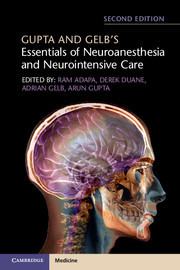Gupta and Gelb's Essentials of Neuroanesthesia and Neurointensive Care (2nd Ed., Revised edition)
Langue : Anglais
Coordonnateurs : Gupta Arun, Gelb Adrian, Duane Derek, Adapa Ram

This second edition presents core clinical neuroanesthesia and neurointensive care knowledge in a practical, user-friendly format.
This updated second edition of Gupta and Gelb's Essentials of Neuroanesthesia and Neurointensive Care contains the ideal combination of updated information for the practitioner, presented in easy-to-digest short chapters. With an essential clinical focus on key neuroanesthesia and neurointensive care knowledge, it is a practical guide for any practitioner of neuroanesthesia, beginner, occasional or experienced. The user-friendly format contains bullet points to ensure retention of important data, key points to summarize the take-home messages, suitable images to enhance understanding, and pertinent and appropriate references to allow for further exploration of the topics. This book is ideal for residents and others undergoing neuroanesthesia training. It is also a great tool for Operating Room nurses and other OR support workers, neurosurgical residents and neurointensive care professionals. This will also be a useful book to supplement knowledge for postgraduate fellowship and Board examinations.
Part I. Anatomy: 1. Structure and function of the brain and spinal cord; 2. Cerebral circulation; Part II. Physiology: 3. Cerebral blood flow and its control; 4. Cerebral metabolism; 5. The intracranial compartment and intracranial pressure; 6. Cerebral ischemia; 7. Intraoperative brain protection; Part III. Pharmacology: 8. Intravenous anesthetic agents; 9. Volatile anesthetic agents; 10. Opioids and adjuvant drugs; Part IV. Neuroanesthesia: 11. Preoperative assessment; 12. Basic concepts of neuroimaging; 13. Neurosurgical operative approaches; 14. Surgical positioning; 15. Anesthesia for supratentorial surgery; 16. Anesthesia for intracranial vascular lesions; 17. Anesthesia for posterior Fossa lesions; 18. Anesthesia for CSF diversion and endoscopic neurosurgical procedures; 19. Anesthesia for epilepsy surgery and anticonvulsants; 20. Perioperative management of awake craniotomy; 21. Anesthesia for stereotactic and other functional neurosurgery; 22. Anesthesia for pituitary surgery; 23. Anesthesia for patients with head injury; 24. Anesthesia for spinal surgery; 25. Airway management and cervical spine disease; 26. Carotid endarterectomy; 27. Anesthesia and sedation for neuroimaging outside the OR; 28. Anesthesia for interventional neuroradiology; 29. Anesthesia for neurosurgery in infants and children; 30. Anesthetic considerations for pediatric neurotraums; 31. Postanesthesia care unit; Part V. Neurointensive Care: 32. Spinal cord injury; 33. Head injury: initial resuscitation and transfer; 34. Intensive care management of acute head injury; 35. Intracranial hemorrhage: ICU management; 36. Management of acute stroke; 37. Central nervous systems infections; 38. Central venous sinus thrombosis; 39. Autonomic dysfunction; 40. Fluid management; 41. Electrolyte disorders; 42. Status epilepticus; 43. Guillain-Barre syndrome and myasthenia Gravis; 44. Brain death; Part VI. Monitoring: 45. Intracranial pressure monitoring; 46. Jugular venous oximetry; 47. Cerebral oxygenation; 48. Microdialysis; 49. Electromyography and evoked potentials; 50. Electroencephalography and nervous system function monitoring; 51. TCDs and cerebral blood flow measurement; Part VII. Miscellaneous: 52. Neuroanesthesia in pregnancy; 53. Clinical information resources; 54. Case scenarios.
Arun Gupta is a Consultant in Neurosciences and Trauma Critical Care who in 2005 was awarded the Macintosh Professorship by the Royal College of Anaesthetists in recognition of his research program in brain oxygenation and metabolism. As Director of Postgraduate Medical Education for the Trust and multi-professional Education of the Cambridge University Health Partners (CUHP) Academic Health Sciences Centre, he established the high fidelity Simulation Centre at Cambridge and the cadaveric surgical training and research centre. Whilst continuing to pursue his research interests in brain injury, Dr Gupta is also supporting a program of research in Medical Education and Simulation. Dr Gupta has recently established the CUHP Innovation Hub to support new innovations in healthcare and patient safety.
Adrian Gelb MBChB, FRCPC, FRCA is a Distinguished Professor in the Department of Anesthesia and Perioperative Care, University of California, San Francisco. He has served as the leader in multiple national and international Anesthesia Societies having been the President of three societies including the Society for Neuroscience in Anesthesiology and Critical Care (SNACC). Professor Gelb is an active clinician, a funded researcher who is well published with >300 publications, and a frequent international speaker including 16 eponymous lectures.
Derek Duane is a consultant in Neuroanaesthesia and Neurointensive Care for the Cambridge University Hospitals NHS Trust. He has earned a Fellowship of the Royal College of Anaesthetists, a Masters in Neuroscience, and Master in Medical Law and Ethics.
Ram Adapa is a consultant anaesthetist at the Department of Anaesthesia, Addenbrooke's Hospital, Cambridge, and is interested in the neurobiology of consciousness and sedation.
Adrian Gelb MBChB, FRCPC, FRCA is a Distinguished Professor in the Department of Anesthesia and Perioperative Care, University of California, San Francisco. He has served as the leader in multiple national and international Anesthesia Societies having been the President of three societies including the Society for Neuroscience in Anesthesiology and Critical Care (SNACC). Professor Gelb is an active clinician, a funded researcher who is well published with >300 publications, and a frequent international speaker including 16 eponymous lectures.
Derek Duane is a consultant in Neuroanaesthesia and Neurointensive Care for the Cambridge University Hospitals NHS Trust. He has earned a Fellowship of the Royal College of Anaesthetists, a Masters in Neuroscience, and Master in Medical Law and Ethics.
Ram Adapa is a consultant anaesthetist at the Department of Anaesthesia, Addenbrooke's Hospital, Cambridge, and is interested in the neurobiology of consciousness and sedation.
Date de parution : 06-2018
Ouvrage de 426 p.
15.6x23.4 cm
Disponible chez l'éditeur (délai d'approvisionnement : 14 jours).
Prix indicatif 86,49 €
Ajouter au panierThème de Gupta and Gelb's Essentials of Neuroanesthesia and... :
© 2024 LAVOISIER S.A.S.



